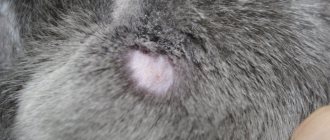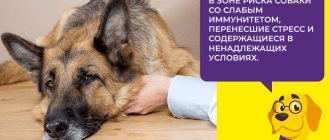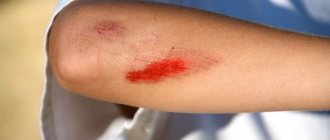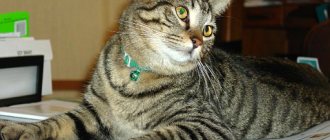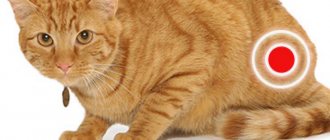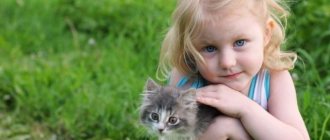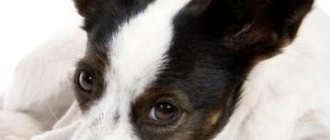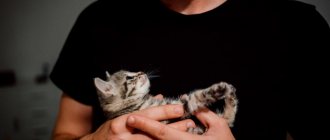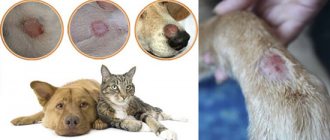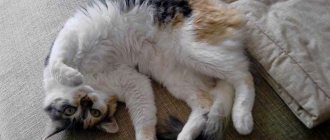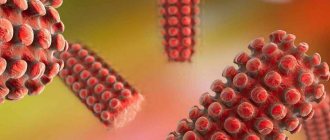Kinds
Science distinguishes between two types of disease. If a person becomes infected from an animal, then the disease is called microsporia, but if a person infected a person, then trichophytosis. Scientists have identified more than 20 types of the causative agent of lichen, which are divided into pathogenic groups (zoophilic, geophilic, atropophilic). Depending on the symptoms that characterize the disease, doctors distinguish several types of it:
- Surface type. The spots appear on open areas of the skin and go away without complications. If the patient receives treatment, the disease disappears within 3-7 days.
- Erythematous-edematous type. Swollen, red, scaly spots appear on a person’s skin, which itch and cause discomfort. The disease is more often diagnosed in children and young women.
- Deep type. Pathogenic microorganisms penetrate deep into the skin, forming spots on the legs covered with keratinized scales.
How to recognize a sick animal
To warn your family against ringworm , you need to know which animal can bring danger. If there are various changes in the coat (hair loss, scratching, dandruff), you should be wary. Mostly, lichen is observed in pregnant and weak cats that have helminths.
On the skin of a quadruped, the formation of round, oval spots with a lack of hair is possible. Broken bristles are visible along the edges. Baldness is often noticed on the paws, tail, and head. The damaged area is reddish in color, peels, crusts or scales may be visible.
The pet feels discomfort due to burning and itching, so it itches constantly. At an advanced stage, the animal loses weight, its fur becomes dull, and indifference to everything appears.
Causes and routes of infection
Feline ringworm is considered contagious, has an infectious nature, and is caused by pathogenic microorganisms. In medicine it is called dermatophytosis, dermatophytosis or dermatomycosis.
You can become infected with lichen not only through contact with stray animals. A pathogenic microorganism can be brought home by a pet if it is walked with, or by the person himself on the soles of his shoes.
The fungus that causes lichen in humans is resistant to disinfectants and can live at home for two years. Children from three to fourteen years of age, pregnant and lactating women, and people with weak immunity are most often infected with lichen.
Transmission from animal to human
Most often, a person becomes infected with the disease after contact with a sick street animal (cat). In this case, the spores of the pathogenic microorganism that cause dermatophytosis are transferred to the pet owner and other pets living in the house.
A person can also catch lichen from a seemingly healthy domestic cat that has no symptoms of the disease. In this case, the animal is a carrier of the fungus, but does not get sick itself, since it has good immunity.
Person-to-person transmission
The disease can easily be contracted from a person who suffers from dermatophytosis. To prevent this from happening, the patient must be isolated from healthy family members and provided with personal bedding and hygiene products.
Pathogen
The causative agent of the disease is the fungus Microsporum canis. The structure of the pathogenic microorganism is similar to mold spores. Once on the skin of a person, cat or dog, after 4-6 hours the fungus grows into the upper layers of the dermis.
Its threads penetrate deeper and deeper into the body over time, receiving nutrition from neighboring tissues. Not only the skin is affected, but also the hair follicles and the hair itself. After a week, microorganisms begin to multiply.
How can you get infected?
Most often, children become infected with cat lichen. If the disease is not recognized in a timely manner and treatment is not started, then a rapid increase in spots on the skin will begin. They begin to become covered with dense gray scales and become very itchy. The rapid spread of fungus over a child’s skin is due to the fact that children scratch the spots, spreading the spores further throughout the skin. It happens that lichen that starts with one small spot quickly spreads throughout the skin. The diameter of cat lichen can be ten centimeters or even more.
Spots that are located nearby can merge into one large lesion and seriously complicate treatment. There is a type of cat lichen that leads to inflammation of the skin and even suppuration. In this case, there may be an increase in temperature and enlargement of the lymph nodes in the neck. One of the most difficult cases of infection with cat lichen is the so-called scab. Hence the word - lousy. This type of disease is very difficult to treat.
You can become infected with cat lichen in a number of ways:
- From contact with a sick cat, fungal spores are transferred to humans and other animals.
- From a cat that appears healthy in appearance and shows no signs of illness. This is due to the fact that she has good immunity and is only a carrier of the disease.
- From a pet that was never allowed outside. The reason for this is that owners can bring fungal spores into the house on their shoes. Such spores are distinguished by their tenacity - they can be active for up to two years.
- From contact with soil, sand and grass containing lichen spores.
No matter how tenacious the spores are, they are easily washed off with soap and water. Therefore, it is necessary to thoroughly wash your hands not only after contact with an animal, but also always upon coming home from the street. Such a hygienic measure reduces the threat of contracting feline lichen to almost zero.
When the fungus develops, bald patches form on the scalp, hence the name ringworm.
Symptoms
Symptoms of lichen vary depending on where the elements of its manifestation are localized (on the skin or scalp). Also, the signs of microsporia depend on how deep the pathogen has entered the body.
Incubation period
The incubation period is the period of time between the moment of transmission of the fungus from a cat to a person until the manifestation of clinical symptoms of the disease.
For some people, the incubation period lasts only one week. During this period, the pathogenic microorganism has time to grow and begin to multiply. It grows so quickly that it causes inflammatory processes on the skin or scalp.
In other cases, the incubation period takes up to three weeks. If a person has a strong immune system, then the disease is expressed by weak clinical manifestations, or they are completely absent.
Typical signs
Typical signs of lichen in humans are as follows:
- Scaly spots with clear boundaries appear on the skin. Gradually, the neoplasms increase in size, thickenings of skin with nodules and crusts appear at the edges.
- If dermatomycosis is localized on the scalp, then round spots form in this area, and the hairs in these places break off almost at the roots. The dermis turns red, peels off, a blistering rash appears on it, and yellow crusts appear.
In addition to the above symptoms, a person may experience itching. Rashes should not be scratched, otherwise fungal spores will spread to healthy areas of the skin.
Atypical manifestations
Atypical forms of the disease are observed in people with systemic diseases. Also, atypical manifestations of lichen develop while taking certain types of medications. They can be recognized by the following signs:
- The infiltrative form is characterized by the fact that many areas with broken hairs appear on the head, which have a red tint and rise above the rest of the dermis.
- The exudative form of the disease is characterized by the fact that the neoplasms look swollen and fluid oozes from them. When they dry, they turn into a crust.
- The purulent form manifests itself in extensive inflammation of the areas of the skin where nodes appear. When pressed, pus oozes out of them.
- The seborrheic form is characterized by thinning of the hair on the head and the appearance of flaking. Foci of inflammation may be absent.
- The trichophytoid form of the disease is diagnosed by the appearance of small spots on the head on which the skin peels. The rashes have no clear boundaries, there is no inflammation.
Other treatments
Hardware methods are also effective:
- Laser therapy. It is used for itchy types of lichen, although it has a beneficial effect on the skin for other types of lesions. For treatment, a laser with low-intensity radiation (red or infrared) is used. Laser radiation has an antibacterial effect, eliminates inflammation and itching, soothes the skin and reduces its sensitivity. This procedure cannot be performed during pregnancy, in the presence of cancer and infectious diseases, blood diseases, open form of tuberculosis, as well as during the acute period of a stroke or heart attack.
- Heliotherapy and UV irradiation. This procedure involves sun treatment in aerosolariums or on equipped therapeutic beaches (they have special roofs with filters). UV rays increase the peeling of the skin, causing all the affected skin to be removed, along with the fungal spores. The optimal duration of exposure to sunlight is 2 hours. It is recommended to choose a time before 11 am or after 16 pm. During the interval between this time, the sun is very aggressive and can have a detrimental effect. While in the sun, it is recommended to drink water in small portions, since UV rays also affect the body's metabolism. It is not recommended to sunbathe on an empty stomach or immediately after eating. The optimal position is lying on a trestle bed about 40 cm high with the head end slightly raised. The head must be in the shade and the eyes must be covered with sunglasses.
- Cryodestruction. The procedure involves the use of liquid nitrogen. The most effective method is for excessive skin lesions. Cryodestruction is approved for use during pregnancy and childhood. During exposure to liquid nitrogen, antimicrobial and antiviral immunity is formed, which prevents secondary infection. It is recommended to use the method in combination with drug therapy.
Is cat lichen dangerous for humans?
Incorrect and untimely treatment of the disease can lead to complications, including death.
Frequent consequences of lichen are:
- blindness;
- development of tumors, including malignant ones;
- baldness;
- viral pneumonia;
- neuralgia;
- hearing impairment;
- meningitis.
Treatment of complications after microsporia is a labor-intensive and long process, so disease prevention measures should be observed and its therapy should be started on time. Contact your doctor and do not self-medicate.
What to do to avoid getting shingles
To protect yourself and your animal from lichen infection, you need to constantly follow simple rules:
- After each trip outside, wash your hands thoroughly with soap (microsporia spores that appear can be easily removed with hot soapy water);
- damage to the skin (cuts, scratches) must be disinfected with antiseptics, and then a bactericidal patch must be applied;
- regularly after a walk outside, or after playing with a child in the sandbox, you should come and wash your shoes;
- do not touch yard dogs and cats, do not allow children near them;
- also protect your cat from contact with homeless people;
- for prevention, the pet must be vaccinated against ringworm;
- Frequently inspect the fur of your four-legged dog and, if you suspect lichen, immediately contact a veterinarian.
Attention! Not every contact with an infected animal leads to illness. A strong human immune system plays a big role. Following hygiene rules and maintaining strong immunity is a strong barrier to fungal spores.
How to avoid getting shingles from a cat ? If you discover this unpleasant disease in your pet and as a personal precaution, you must comply with the following requirements:
- try to limit contact with the animal during treatment, and it is better not to let children near it at all;
- It is advisable to place the cat in another room and not allow him to walk with other individuals;
- do all necessary procedures exclusively with gloves, then wash your hands with soap and disinfect them;
- treat carpets and furniture with steam - this will help eliminate fungal spores more quickly;
- change the cat's bedding daily (throw out the old one or burn it);
- Constantly treat the animal’s personal belongings (bowl, tray) with antifungal antiseptic drugs.
How quickly recovery occurs and the cat’s lichen will depend on its owner. The room in which the pet lives should be cleaned every day using disinfectants.
Diagnostics
In addition to a visual examination, the doctor prescribes additional methods for diagnosing dermatophytosis:
- Bacteriological research. For examination, skin and hair samples are taken from the affected areas. They are studied using a microscope.
- Use of Wood's lamp. The device emits ultraviolet light, and the affected hairs glow green when used. Using the method, you can detect lichen in the early stages if only one hair is affected.
- Culture method. It is used after the examinations described above in order to determine the type of fungus and prescribe the correct treatment. Human biomaterial is placed in a nutrient medium, then the growth of pathogen colonies is observed.
The first steps after infection are deprived
Knowing how dangerous lichen is for humans, it is important to competently take the first steps when symptoms occur. At the initial signs of infection, you should immediately consult a dermatologist. Self-medication is strictly prohibited. Often people begin to use traditional methods - these actions lead to the fact that the lichen spreads throughout the body even more and more actively.
To determine the type of disease, laboratory tests are prescribed. During the treatment period, the patient is limited in contact with other family members. At the same time, the pet needs to be treated.
Many cat owners are concerned about the question of whether fungal spores pass from humans to cats. Can a sick owner infect an animal? Doctors say that such an infection is also possible. Therefore, if the owner became infected with ringworm on the street, and the pet is healthy, it is necessary to limit contact and give the animal a vaccine against ringworm.
How to treat feline ringworm in humans?
Modern medications allow you to get rid of the disease quite quickly, although they do not protect against its relapses and the development of a chronic form.
Taking medications
Local treatment of the disease involves the use of ointments:
- Clotrimazole;
- Ketoconazole;
- Triderm;
- Lamisil;
- Bifonazole.
The patient is also prescribed medications for oral administration (antibacterial tablets, medications containing iodine, immunomodulators, antihistamines and antiallergic drugs):
- Mycozoral;
- Claritin;
- Griseofulvin;
- Fluconazole;
- Amiksin;
- Iodinol.
The use of special shampoos (Nizoral, Sulsena) is often added to the main treatment for lichen localized on the scalp, as they contain antifungal components.
Folk remedies
Remedies made according to folk recipes should be used with caution in the treatment of microsporia after permission from the treating specialist. The most commonly used are the following:
- Propolis. Propolis tincture from the pharmacy is lubricated daily on the affected skin areas. Gradually the disease recedes.
- Tincture of calendula. Rub the product over the skin rashes at least five times a day until the spots disappear completely.
- Vinegar. Microsporia stains are smeared with apple cider vinegar several times a day. The pathogenic microorganisms that cause lichen gradually die.
- Iodine solution. The product is diluted with water in proportions 1:1. The resulting composition is used to treat the affected areas on the head or other skin.
Diet
During the treatment period, it is important to follow a diet that consists of proper nutrition. You should avoid alcoholic beverages, fast food, pickled vegetables, canned food, spicy and fried foods, and sweets.
Cat treatment
The cat is treated by a veterinarian. Therapy is complex and includes the use of the following medications:
- Vaccines (Microderm, Vakderm F). They are used at the initial stage of the disease and are administered according to the standard regimen.
- Local processing. Skin lesions are treated with antifungal drugs (Miconazole, Sanoderm), chlorhexidine or iodine solution. The wool from the treated area is pre-cut and burned.
- Tablets (Terbinafine, Itraconazole). Used if preparations for external treatment are ineffective. Medications have side effects, so they are rarely given to pregnant cats.
Folk remedies for treatment
Folk remedies can only be an additional treatment to help get rid of unpleasant sensations. The most effective treatments for feline ringworm are the following:
- Apple vinegar. Compresses with this remedy are effective. To do this, soak a cloth in vinegar and then apply it to the affected area. The number of procedures per day should be six. The last time the compress should be applied is before going to bed. Vinegar effectively fights the itching that often accompanies lichen, and prevents further spread of the disease. This is due to the fact that vinegar changes the habitat of the fungus, changing its acid-base balance towards oxidation. The fungus cannot live in such conditions, so it dies. In addition, apple cider vinegar contains a large amount of amino acids that promote rapid skin regeneration.
- Newspaper ash. A large newspaper needs to be rolled into a tube and tied in three places. Place this bundle on the bottom of the plate and set it on fire. Allow the newspaper to burn completely. The brown substance that forms on the plate has medicinal properties. Without waiting for it to cool, lubricate the affected area. Two or three procedures are enough for recovery. Newspaper ash has a detrimental effect on the fungus that causes lichen. Newspaper paint contains zinc, which is an antiseptic and has a restorative and strengthening effect on the skin. Because of this, ashes are able to relieve itching, dry and disinfect it, and protect the healthy epidermis from further spread of infection.
- Tar. It (150 g) must be mixed with two yolks, 100 g of cream. Rub this mixture into the affected areas twice a day. Tar can also be mixed with butter. Apply the resulting mixture to the affected area and then apply a bandage. Do this procedure at night. Tar promotes tissue rejuvenation and renewal. This product also has a disinfecting effect.
Prevention of feline lichen in humans
To protect yourself from the development of microsporia, doctors recommend taking the following preventive measures:
- Vaccinate domestic cats.
- Examine the skin of your pet, adults and children living in the house.
- Regularly carry out wet cleaning using disinfectants.
- If your pet has spots on the skin, bald patches, or hair loss, contact a veterinary clinic immediately.
- Observe the rules of personal hygiene, wash your hands after going outside or contacting animals.
- Try to avoid contact with street cats and dogs.
First steps after infection
At the first symptoms of infection, you should visit a dermatologist to establish a diagnosis. Under no circumstances should you independently diagnose, let alone treat, ringworm. The use of traditional methods and ineffective remedies will lead to the disease spreading throughout the body, and the treatment will be lengthy.
The dermatologist decides how to treat cat lichen in humans. Therapy is complex and includes both the use of external agents and oral administration of antifungal drugs. As a rule, for microsporia, local medications are prescribed: ointments, creams, sprays, solutions that have a mycotoxic effect. For treatment, a 5% tincture of iodine and a 10% solution of quinozol are used. The following ointments and creams have a good therapeutic effect:
- "Nizoral"
- "Mikoseptin"
- "Clotrimazole"
- "Bifonazole"
- "Lamisil"
- other.
If microsporia of the scalp is observed, then antimicrobial antibiotics are used for internal use, for example, Griseovulfine, Terbinafine.
If a child has lichen from a cat, how to treat this? If microsporia is detected, children are isolated to prevent an epidemic in the children's group. The same medications are used to treat the disease as for adults. The dosage and frequency are prescribed by a dermatologist.
Thorough disinfection of clothing, personal hygiene items and household items plays an important role in the effectiveness of therapy. Throughout treatment for ringworm, it is necessary to regularly disinfect the premises using antifungal agents (chlorhexidine, bleach, etc.). The best way to disinfect a room from fungal spores is regular 15-minute quartzing.
Feline lichen in a child
The disease is often diagnosed in children aged 3 to 8 years. A child can pick up a fungus in a sandbox or by interacting with an outdoor cat.
If you see rashes and spots on your child’s skin, you should visit a dermatologist. Recovery will come faster if the baby does not have contact with a sick animal.
During the treatment period, the child’s skin should not be subjected to water procedures (except for a shower) or washed with washcloths. There should be no sources of allergens in the patient’s room, that is, soft toys, carpets. You need to wet clean the room every day.
Prevention measures
To prevent your cat from getting shingles, you need to take some precautions. Firstly, you should not touch unfamiliar animals on the street, because feline lichen is easily transmitted to humans. And if you have already pet the animal, you need to immediately wash your hands. Secondly, it is not recommended to neglect daily inspection of your pet for lesions. Thirdly, it is worth periodically disinfecting personal belongings, especially those with which the animal often comes into contact. Fourthly, in the autumn-spring period you need to take vitamin complexes to prevent weakening of the immune system. Fifthly, if signs of lichen are detected on the body of family members or animals, you must immediately consult a doctor.
Pets give people many positive emotions, but we should not forget about the dangers they can bring with their fur. Although lichen is not a fatal disease, it can significantly worsen the life of a cat owner and his family. Therefore, it is very important to quickly detect the disease and begin treatment.
Feline ringworm during pregnancy and lactation
Treatment of microsporia in pregnant women should be started as soon as possible. This will avoid consequences for the unborn child. Therapy during pregnancy consists of treating the skin with iodine solution or salicylic ointment; washing hair with special shampoos is allowed. Taking antibacterial drugs is highly undesirable.
To avoid contracting shingles, a pregnant woman needs to regularly wash her hands, take vitamins and eat healthy foods to strengthen the body's defenses.
Are other non-dermatological diseases transmitted to humans from cats?
Many people are concerned about the question of what can be infected from a cat. In fact, there are quite a lot of non-dermatological diseases transmitted from these animals to people. Some of them are fatal. Information about the methods of transmission of diseases that pass from cats to people, and about the signs by which a sick animal can be recognized, is presented in the table:
| Name of the disease | Transmission routes | Symptoms |
| Rabies | Bite or saliva getting into the wound | Decreased appetite, vomiting, diarrhea, hypersalivation, photophobia, unmotivated aggression or excessive intrusiveness, paralysis of the muscles of the whole body. |
| Toxoplasmosis | Contact with pet feces | Increased body temperature, enlarged lymph nodes, lethargy, vomiting, diarrhea, breathing problems, loss of interest in food, eye inflammation. |
| Worm infestation | Close contact with an animal | Weakness, loss of appetite, indigestion, deterioration of coat condition, itching in the anus, perversion of taste preferences. |
| Chlamydia | Airborne | Conjunctivitis, lack of appetite, fever, purulent discharge from the nasal passages, cough, sneezing, wheezing. |
| Salmonellosis | Any contact with a sick pet | A sharp increase in body temperature, avoidance of contact with people, apathy, lack of appetite, blood in the stool, vomiting, diarrhea, hypersalivation, muscle cramps, purulent discharge from the eyes and nose, respiratory failure, cough. |
| Campylobacteriosis | Indigestion, inclusion of pus, mucus and blood in the stool, slight increase in body temperature. | |
| Tuberculosis | Sneezing, coughing, lethargy, digestive problems, loss of appetite, swollen lymph nodes. |
Signs of lichen
Each type of lichen has its own symptoms:
- Ringworm. Round spots with jagged edges form on the head. The hair in these areas falls out, and the spots themselves peel off.
- Pityriasis rosea. In this case, spots of rich pink or light brown color are formed. The edges of the spots end with a red rim.
- Shingles. The culprit of the disease is the herpes virus. The lesions are located on the sides of a person’s ribs, affecting intercostal or stem nerve endings. With this lichen there is characteristic pain and mild itching.
- Lichen planus. With this condition, severe itching and bright red rashes are felt on the skin and mucous membranes.
- Pityriasis versicolor. This form of lichen is clearly visible on dark or tanned skin and looks like flaky light spots.
